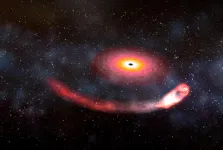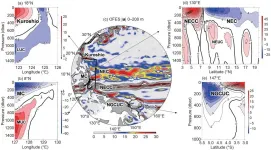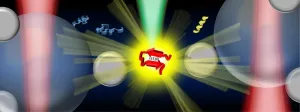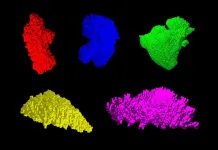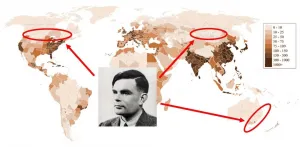(Press-News.org) Studying the violent collisions of black holes and neutron stars may soon provide a new measurement of the Universe's expansion rate, helping to resolve a long-standing dispute, suggests a new simulation study led by researchers at UCL (University College London).
Our two current best ways of estimating the Universe's rate of expansion - measuring the brightness and speed of pulsating and exploding stars, and looking at fluctuations in radiation from the early Universe - give very different answers, suggesting our theory of the Universe may be wrong.
A third type of measurement, looking at the explosions of light and ripples in the fabric of space caused by black hole-neutron star collisions, should help to resolve this disagreement and clarify whether our theory of the Universe needs rewriting.
The new study, published in Physical Review Letters, simulated 25,000 scenarios of black holes and neutron stars colliding, aiming to see how many would likely be detected by instruments on Earth in the mid- to late-2020s.
The researchers found that, by 2030, instruments on Earth could sense ripples in space-time caused by up to 3,000 such collisions, and that for around 100 of these events, telescopes would also see accompanying explosions of light.
They concluded that this would be enough data to provide a new, completely independent measurement of the Universe's rate of expansion, precise and reliable enough to confirm or deny the need for new physics.
Lead author Dr Stephen Feeney (UCL Physics & Astronomy) said: "A neutron star is a dead star, created when a very large star explodes and then collapses, and it is incredibly dense - typically 10 miles across but with a mass up to twice that of our Sun. Its collision with a black hole is a cataclysmic event, causing ripples of space-time, known as gravitational waves, that we can now detect on Earth with observatories like LIGO and Virgo.
"We have not yet detected light from these collisions. But advances in the sensitivity of equipment detecting gravitational waves, together with new detectors in India and Japan, will lead to a huge leap forward in terms of how many of these types of events we can detect. It is incredibly exciting and should open up a new era for astrophysics."
To calculate the Universe's rate of expansion, known as the Hubble constant, astrophysicists need to know the distance of astronomical objects from Earth as well as the speed at which they are moving away. Analysing gravitational waves tells us how far away a collision is, leaving only the speed to be determined.
To tell how fast the galaxy hosting a collision is moving away, we look at the "redshift" of light - that is, how the wavelength of light produced by a source has been stretched by its motion. Explosions of light that may accompany these collisions would help us pinpoint the galaxy where the collision happened, allowing researchers to combine measurements of distance and measurements of redshift in that galaxy.
Dr Feeney said: "Computer models of these cataclysmic events are incomplete and this study should provide extra motivation to improve them. If our assumptions are correct, many of these collisions will not produce explosions that we can detect - the black hole will swallow the star without leaving a trace. But in some cases a smaller black hole may first rip apart a neutron star before swallowing it, potentially leaving matter outside the hole that emits electromagnetic radiation."
Co-author Professor Hiranya Peiris (UCL Physics & Astronomy and Stockholm University) said: "The disagreement over the Hubble constant is one of the biggest mysteries in cosmology. In addition to helping us unravel this puzzle, the spacetime ripples from these cataclysmic events open a new window on the universe. We can anticipate many exciting discoveries in the coming decade."
Gravitational waves are detected at two observatories in the United States (the LIGO Labs), one in Italy (Virgo), and one in Japan (KAGRA). A fifth observatory, LIGO-India, is now under construction.
Our two best current estimates of the Universe's expansion are 67 kilometres per second per megaparsec (3.26 million light years) and 74 kilometres per second per megaparsec.
The first is derived from analysing the cosmic microwave background, the radiation left over from the Big Bang, while the second comes from comparing stars at different distances from Earth - specifically Cepheids, which have variable brightness, and exploding stars called type Ia supernovae.
Dr Feeney explained: "As the microwave background measurement needs a complete theory of the Universe to be made but the stellar method does not, the disagreement offers tantalising evidence of new physics beyond our current understanding. Before we can make such claims, however, we need confirmation of the disagreement from completely independent observations - we believe these can be provided through black hole-neutron star collisions."
The study was carried out by researchers at UCL, Imperial College London, Stockholm University and the University of Amsterdam. It was supported by the Royal Society, the Swedish Research Council (VR), the Knut and Alice Wallenberg Foundation, and the Netherlands Organisation for Scientific Research (NWO).
INFORMATION:
Under the background of global warming, the energy budget of the earth is out of balance with more than 90% of additional heat entering the ocean.
The tropical Pacific Ocean has an important influence on the global tropical climate and the climate of China, and the tropical Pacific Western Boundary Currents (WBCs) that flow through it plays an important role in the climate system. Large-scale ocean circulation redistributes ocean heat and mass and is hence one of the basic dynamic processes that shape the earth's Marine environment. The tropical Pacific WBCs system is a key part of the global ocean circulation system. ...
It is challenging to analyze proteins at low concentrations, especially for those in a mixture of various conformations such as intrinsically disordered proteins (IDPs). A research team led by Prof. HUANG Jinqing, Assistant Professor of Department of Chemistry at The Hong Kong University of Science and Technology (HKUST), has developed optical tweezers-coupled Raman spectroscopy that can directly probe the structural features of alpha-synuclein, an IDP closely linked to Parkinson's disease, at the physiological concentration by focusing on individual protein molecules.
IDPs play an important role in biological processes and many of them are associated with incurable neurodegenerative ...
Researchers from the Universities of Bristol and Surrey have found that well-fitting, three-layered cloth masks can be as effective at reducing the transmission of COVID-19 as surgical masks.
At the height of the COVID-19 pandemic, 139 countries mandated the use of face coverings in public space such as supermarkets and public transports. The World Health Organization also advises the use of face coverings and offers guidance on their effective features. Face coverings suppress the onward transmission of COVID-19 through exhalation and protect the wearer on inhalation.
In a paper published by the Physics of Fluids journal, the researchers detail how they looked at how liquid ...
Areas in Sweden with early access to electricity at the start of the 1900s underwent rapid change. Electrification led to more strikes, but it was not those who were threatened by the new technology who protested. Instead, it was the professional groups who had acquired a stronger negotiating position - thanks to technological development, according to new research from Lund University.
Labour market conditions are affected by new technology. Currently, the impact of automation on the labour market is often discussed, whether jobs will disappear as computers take over, or whether digitalisation drives development towards a gig economy with uncertain employment conditions. One fear is that the technological development could generate social unrest and a risk of increased ...
Like a chameleon of the night sky, the Moon often changes its appearance. It might look larger, brighter or redder, for example, due to its phases, its position in the solar system or smoke in Earth's atmosphere. (It is not made of green cheese, however.)
Another factor in its appearance is the size and shape of moon dust particles, the small rock grains that cover the moon's surface. Researchers at the National Institute of Standards and Technology (NIST) are now measuring tinier moon dust particles than ever before, a step toward more precisely explaining the Moon's apparent color ...
Researchers from the University of Copenhagen, in collaboration with their Swiss colleagues at the University Hospital of Bern, have cracked the code for controlling a group of enzymes that affect our metabolism.
The researchers' findings could help us avoid diseases ranging from high cholesterol to infertility to certain types of cancer, which are all due, among other things, to hormonal imbalances.
They have found a way to influence a special protein called cytochrome P450 reductase (POR) -- popularly characterized as the 'conductor' of the body's protein orchestra, which helps regulate our hormones and makes it possible to break down medicinal products in the liver.
"We have developed a method to ...
Fast growth of the global human population has long been regarded as a major challenge that faces mankind. Presently, this challenge is becoming even more serious than before, in particular because many natural resources are estimated to deplete before the end of this century.
The increasing population pressure on agriculture and ecosystems and the environment more generally is predicted to result in worldwide food and water shortages, pollution, lack of housing, poverty and social tension. The situation is exacerbated by global climate change as considerable areas of land are predicted to be flooded and hence taken out of human's use.
It is widely believed ...
According to the researchers, three songs from a playlist are enough to identify the person who chose the songs. Hence, companies like YouTube and Spotify can accumulate a great deal of information about their users based only on their musical preferences.
The study was led by Dr. Ori Leshman of the Jaime and Joan Constantiner School of Education at Tel Aviv University and Dr. Ron Hirschprung of the Department of Management and Industrial Engineering at Ariel University. The study was published in the journal Telematics and Informatics.
The study included ...
PITTSBURGH, April 28, 2021 - Asthma exacerbations rose following a catastrophic Christmas Eve fire two years ago that destroyed pollution controls at the Clairton Coke Works--the largest such facility in the nation, a University of Pittsburgh Graduate School of Public Health analysis concludes.
The study, published in the Journal of Allergy and Clinical Immunology, was possible because of a collaboration with the University of Pittsburgh Asthma and Environmental Lung Health Institute at UPMC and the Allegheny County Health Department, with funding from The Heinz Endowments.
"In addition to verifying that people living within a 10-mile radius of the coke works had higher rates of asthma exacerbations and use of albuterol rescue medication than those living outside the radius, we learned ...
A comprehensive study from Uppsala University demonstrates that socioeconomic deprivation modifies genetic effects on higher education and abstract reasoning. The paper illustrates how genes play a greater role in educational attainment in more socioeconomically deprived regions of the United Kingdom. The study was recently published in the American Journal of Psychiatry.
Education is an important factor in an individual's life and strongly linked to economic outcomes and quality of life. The likelihood of completing higher education is partly determined by genetic factors. Common genetic variants have previously been estimated to contribute 11-13% ...
